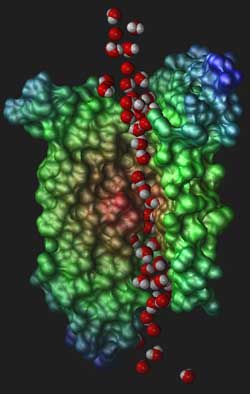Winning an Uphill Battle
Cells use molecular pumps to actively force particular molecules and ions to flow in or out through their membranes. In contrast, channel proteins act as simple tubes through which molecules can travel in either direction–or so researchers have assumed. In recent years, some biophysicists have suggested that passive channel proteins may pass certain molecules one way more readily than the other and even against a concentration gradient.
Now Ioan Kosztin of the University of Missouri in Columbia and Klaus Schulten of the University of Illinois, Urbana-Champaign, have used the detailed atomic structure of a channel protein from the E. coli bacterium to show that, at least in principle, it can transport glycerol in “reverse.” The tubular molecule is called glycerol uptake facilitator, or GlpF, and the key to its ability to go against the flow is its asymmetrical shape.
As a glycerol molecule squeezes through GlpF, it experiences a sequence of pushes and pulls. Physicists describe these with a mathematical function called the “potential of mean force,” which contains peaks and valleys that the glycerol must cross. Two years ago Schulten and colleagues used the atom-by-atom structure of GlpF to calculate the exact potential. Now Kosztin and Schulten have used the potential to calculate what happens if the cell membrane vibrates in and out–as other researchers have recently observed in other cells.
Kosztin and Schulten found that the glycerol molecule acts a bit like a marble on a board covered with thick shingles. The vibrations of the cell and channel are equivalent to tipping the board from side to side. When the board tips so that the shingles lie like they do on a roof, the marble can roll freely from one down onto the next. But when the board tips the other way, the marble will get stuck on the raised edge of a shingle. So the rocking board acts like a ratchet, and the marble travels in one direction, rather than staying put on average.
The ratcheting action of the vibrating channel is more subtle. The jiggling motion of GlpF can nudge glycerol either way, but it pushes glycerol out of the cell more efficiently than it pulls it in. So when the concentration of glycerol in the cell is very low and there is little to expel, the jiggling channel speeds the flow inward. But as the internal concentration increases toward the external concentration, the molecule shuttles more glycerol the other way, effectively reversing the flow and moving it “uphill” against the concentration gradient. Thus, the ratcheting channel helps maintain the glycerol concentration in the cell at its optimal level, Kosztin says. And as protein channels are generally asymmetric, many of them may have some ratcheting ability.
Others have proposed simplistic “toy models” of ratcheting channels, but “this is the first plausible demonstration of a rocking ratchet in a biological system,” says Dean Astumian of the University if Maine in Orono. Although molecular pumps probably account for most of the one-way transport through cell membranes, before such pumps evolved, Astumian speculates, “this could have been the major way that cells harvested” nutrients.
–Adrian Cho
Adrian Cho is a freelance science writer in Grosse Pointe Woods, Michigan.
More Information
more on GlpF from the University of Illinois





